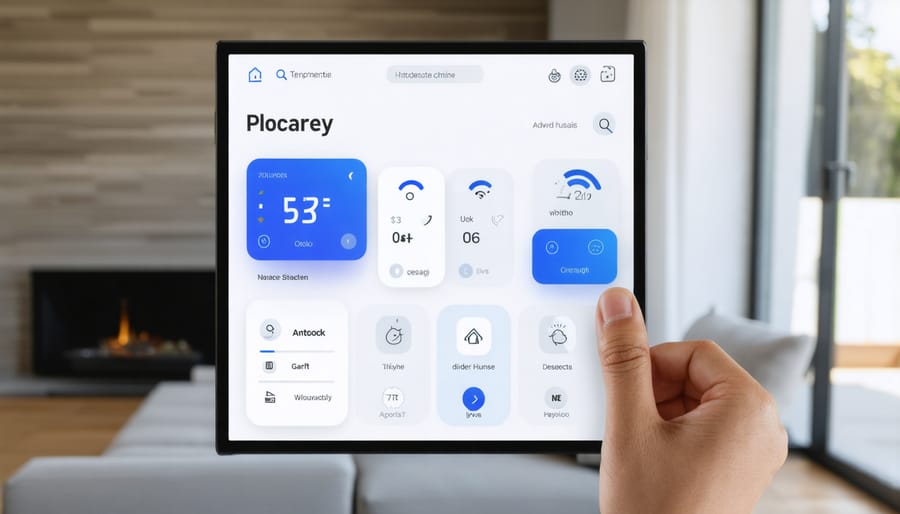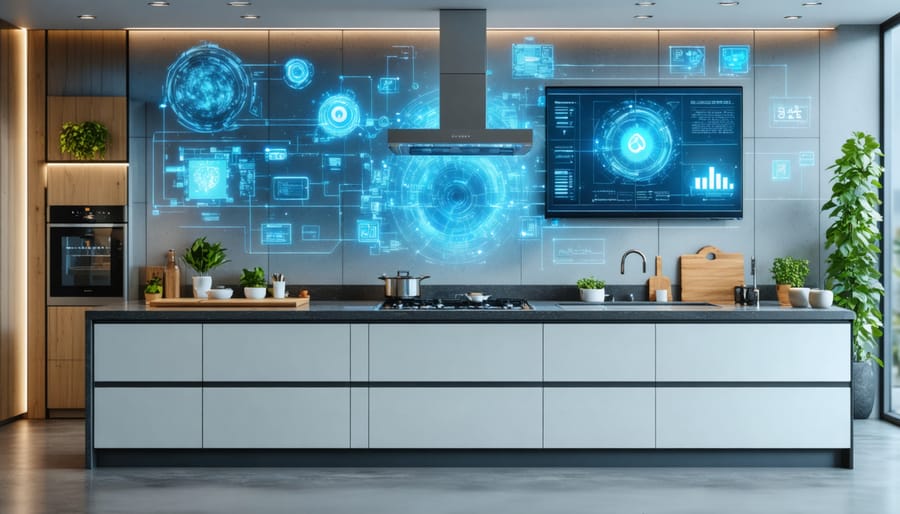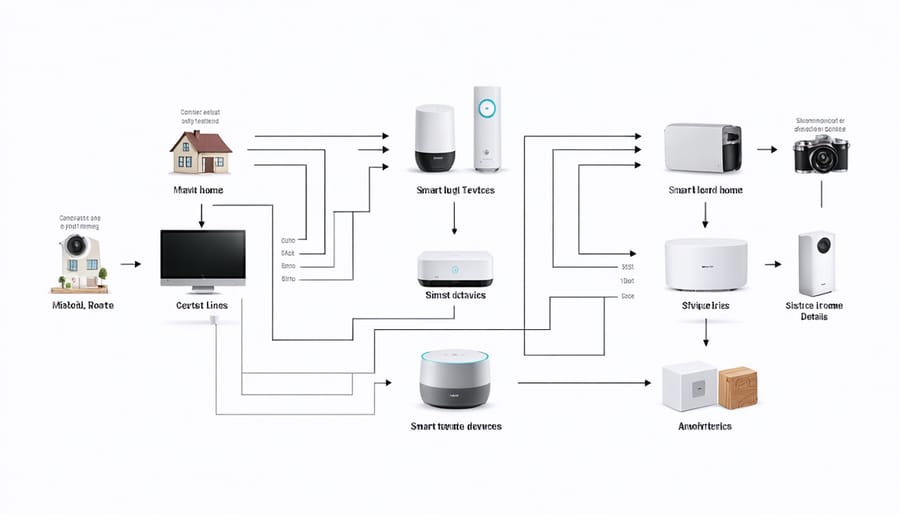Transform your home into an accessible sanctuary with modern smart home systems designed specifically for those who need assistive technology. Voice-controlled lighting, automated door systems, and intelligent environmental controls now make independent living more achievable than ever before. These innovative solutions seamlessly integrate with existing home setups, providing both enhanced accessibility and improved quality of life for individuals with mobility challenges, visual impairments, or other disabilities.
Smart home assistive technology represents more than just convenience—it’s a powerful tool for maintaining independence, ensuring safety, and promoting dignity. From medication reminders and fall detection systems to adaptive thermostats and security features, these technologies create an environment that anticipates and responds to unique needs. Best of all, these systems can be customized and scaled according to individual requirements, making them suitable for both minor adaptations and comprehensive home modifications.
Whether you’re a caregiver looking to provide better support or someone seeking to maintain independence, smart home assistive technology offers practical, reliable solutions that grow and adapt with changing needs. The technology is becoming more affordable, user-friendly, and sophisticated with each passing year, opening new possibilities for inclusive living spaces.
How Smart Homes Are Becoming More Intuitive
Personalized Comfort Settings
Imagine walking into a room that automatically adjusts to your perfect comfort level – that’s exactly what personalized comfort settings in smart homes deliver. These intelligent systems learn your preferences over time, creating an environment that’s tailored just for you.
Modern smart thermostats go beyond simple temperature control by learning your daily routines and preferred settings. They can automatically adjust the temperature before you wake up, while you’re at work, or when you’re heading to bed. Some systems even recognize different family members and adjust settings based on who’s home.
Smart lighting takes personalization to the next level by memorizing your preferred brightness levels and color temperatures throughout the day. Whether you need bright, energizing light in the morning or warm, relaxing tones in the evening, these systems adapt automatically.
Environmental controls don’t stop there – smart homes can manage humidity levels, air quality, and even window shades based on your preferences and the time of day. Many systems also factor in external conditions like weather and sunlight to maintain optimal comfort while maximizing energy efficiency.
The best part? Once set up, these systems work quietly in the background, requiring minimal input while delivering maximum comfort.

Voice-Activated Solutions
Voice-activated solutions have revolutionized how we interact with our homes, making daily tasks more accessible for everyone. With systems like Amazon Alexa, Google Assistant, and Apple’s Siri, you can control various aspects of your home simply by speaking commands.
These smart assistants can help with everything from adjusting thermostats and lighting to setting reminders and making phone calls. For those with mobility challenges, voice commands eliminate the need to physically reach switches or buttons. Simply saying “Turn on the kitchen lights” or “Lock the front door” makes home management effortless.
Setting up voice control is surprisingly straightforward. Most systems come with user-friendly apps that guide you through the process, and they’re compatible with a wide range of smart home devices. You can start small with basic commands and gradually expand your system’s capabilities as you become more comfortable.
Pro tip: Place voice-activated devices in central locations where they can easily hear commands from multiple areas. Consider having one in each major room for seamless coverage throughout your home.
Essential Smart Home Features for Every Family
Automated Security and Safety
Modern smart homes offer unprecedented security features that give you peace of mind while making daily life easier. With a proper home security setup, you can monitor and protect your living space from anywhere in the world.
Smart locks have revolutionized home access, allowing you to create temporary codes for visitors, check lock status remotely, and receive notifications when doors are opened. Many models integrate with your smartphone and can automatically unlock as you approach, which is particularly helpful when carrying groceries or assisting family members with mobility challenges.
Security cameras have become more intelligent and accessible, offering features like facial recognition, motion detection, and two-way audio communication. Place them strategically around your home to monitor entrances, common areas, and outdoor spaces. Modern systems can distinguish between regular activity and potential threats, sending alerts only when necessary.
Emergency response systems have evolved beyond the traditional panic button. Today’s solutions include fall detection, automated emergency calls, and integration with medical alert services. Some systems can even monitor unusual changes in daily routines and alert caregivers or family members when something seems amiss.
For added safety, these security features can work together seamlessly. For instance, when smoke detectors activate, the system can automatically unlock doors for first responders and turn on pathway lighting. This interconnected approach ensures that your home isn’t just secure – it’s actively working to protect you and your loved ones.
Smart Kitchen Assistance
Modern kitchen technology has revolutionized cooking and meal preparation for people with diverse needs and abilities. From voice-controlled appliances to automated cooking systems, these smart kitchen features make daily tasks more accessible and enjoyable.
Smart refrigerators with adjustable shelves and door-mounted displays help users easily locate items and manage grocery lists through voice commands. Motion-sensor faucets eliminate the need for manual operation, while height-adjustable countertops accommodate users in wheelchairs or those who need to sit while preparing meals.
Connected cooking appliances offer remarkable safety features, such as automatic shut-off capabilities and temperature monitoring. Smart ovens can be controlled remotely through smartphone apps, allowing users to adjust settings without reaching over hot surfaces. Voice-activated microwaves and coffee makers simplify beverage preparation, while smart cabinet organizers with pull-down shelving systems bring items within easy reach.
For those with visual impairments, talking meat thermometers and kitchen scales provide accurate measurements through audio feedback. Smart lighting systems automatically illuminate work areas and can be voice-controlled for hands-free operation. Additionally, smart dispensers for ingredients and seasonings help maintain precise portions and prevent spills.
These innovations not only enhance independence in the kitchen but also provide peace of mind for caregivers through remote monitoring capabilities and emergency alerts.

Simplified Home Management
Imagine coming home to a house that practically takes care of itself. That’s the reality of modern smart home management systems. Robot vacuums and mops work tirelessly to keep your floors spotless, while smart sensors monitor air quality and automatically adjust ventilation. These intelligent helpers learn your cleaning preferences over time, becoming more efficient with each use.
Maintenance becomes a breeze with smart sensors that alert you before problems arise. Water leak detectors can spot potential flooding issues, while HVAC monitoring systems remind you when it’s time to change filters or schedule maintenance. Some systems even track your appliances’ performance, predicting potential breakdowns before they happen.
The real magic happens in routine task automation. Smart home hubs can create schedules for everything from watering plants to adjusting thermostats. Voice commands make it simple to add tasks to your home’s to-do list, and automated reminders ensure nothing falls through the cracks. For example, your smart home can remind you about trash collection days or automatically order household supplies when they run low.
What’s particularly helpful is how these systems can be customized to your specific needs. Whether you’re managing a busy family household or living independently with mobility challenges, smart home automation adapts to your lifestyle. The best part? Most of these features can be controlled right from your smartphone, making home management simpler and more efficient than ever before.
Setting Up Your Smart Home System
Getting Started: Core Components
Setting up a smart home assistive system doesn’t have to be overwhelming. Let’s break down the essential components you’ll need to create a foundation that you can build upon over time.
First, you’ll need a reliable home internet connection and a central hub to control your devices. Popular options include Amazon Echo, Google Home, or Apple HomePod. These hubs serve as your system’s brain, processing voice commands and coordinating your connected devices.
Next, consider these basic components:
1. Smart speakers for voice control throughout your home
2. Smart plugs to automate standard electrical devices
3. Smart lights that can be controlled remotely or scheduled
4. Motion sensors for automated responses
5. A smart thermostat for climate control
6. Video doorbell for enhanced security
7. Smart locks for keyless entry
On the software side, you’ll need:
– Your hub’s companion app (Alexa, Google Home, or Apple Home)
– A stable Wi-Fi network
– Individual device apps for setup
– IFTTT or similar automation software for creating custom routines
Start with a few essential pieces rather than trying to automate everything at once. Perhaps begin with a hub and smart lights in your most-used rooms, then add smart plugs for existing lamps or appliances. This approach lets you learn the system gradually while identifying which features benefit you most.
Remember to choose devices that are compatible with your selected hub platform. Most modern smart home products work with multiple systems, but it’s always worth double-checking before purchasing.

Integration Tips
Getting your smart home devices to work together smoothly is key to creating a truly helpful assistive environment. Start by choosing devices that speak the same language – popular protocols like Zigbee, Z-Wave, or Wi-Fi are your best bets. Think of these as the common languages that let your devices chat with each other.
A central hub or smart speaker is your command center. Whether you choose Amazon Alexa, Google Home, or Apple HomeKit, stick to devices that are compatible with your chosen ecosystem. Before buying any new device, double-check its compatibility in the product specifications.
Create device groups for smoother operation. For example, group all your bedroom lights together so one command controls them all. This makes daily routines much simpler, especially for those with mobility challenges.
Set up automated routines to make devices work together automatically. A morning routine might gradually turn on lights, raise blinds, and adjust the thermostat – all without any manual input. These sequences can be incredibly helpful for maintaining independence.
Keep your network strong by positioning your router centrally and considering mesh Wi-Fi if you have a larger home. A stable connection is crucial for reliable device communication.
Regular software updates are essential – they often include compatibility improvements and new features. Set devices to update automatically when possible, and check for updates monthly if manual updates are required.
Finally, document your setup. Keep a simple list of which devices work together and their basic commands. This helps troubleshoot issues and makes it easier for caregivers or family members to assist when needed.
Future-Proofing Your Smart Home
As smart home technology continues to evolve, making informed decisions about your assistive tech setup becomes crucial for long-term success. The key to future-proofing your smart home lies in choosing expandable systems that can grow with your needs and adapt to emerging technologies.
Start by selecting devices and platforms with open protocols like Z-Wave or Zigbee, which ensure compatibility with a wide range of current and future products. These standards allow you to mix and match devices from different manufacturers while maintaining seamless integration. When considering new additions to your system, factor in smart home energy costs and potential savings over time.
Looking ahead, voice control technology is becoming increasingly sophisticated, with better natural language processing and more nuanced command interpretation. Consider installing systems that can be upgraded through software updates rather than requiring complete hardware replacement. Cloud-based platforms often offer this flexibility, allowing your system to gain new features automatically.
Artificial intelligence and machine learning are reshaping how smart homes understand and respond to residents’ needs. Future systems will better predict patterns, adjust automatically to changing circumstances, and provide more personalized assistance. When planning your setup, look for devices that incorporate AI capabilities or have the potential for AI integration through updates.
Another emerging trend is the integration of health monitoring features into everyday smart home devices. From sleep tracking through smart mattresses to air quality monitoring via smart thermostats, these innovations are becoming increasingly important for aging-in-place solutions.
To maintain flexibility for future upgrades, consider installing neutral infrastructure like ethernet cables in key locations and ensuring your Wi-Fi network can handle increased device loads. Create dedicated spaces for hub equipment and plan for backup power solutions to keep critical assistive features running during outages.
Remember that the goal isn’t to implement every new feature immediately, but to build a foundation that can easily accommodate useful innovations as they become available. This approach helps manage costs while ensuring your smart home remains capable of supporting your needs for years to come.
Smart home assistive technology has transformed the way we live, making our homes more accessible, comfortable, and efficient. From voice-controlled lighting to automated security systems and smart health monitoring devices, these innovations empower independence and enhance quality of life for everyone, especially those with specific needs. By starting small with basic smart devices and gradually expanding your system, you can create a personalized, supportive environment that works for you and your family. Remember, the journey to a smarter home doesn’t have to be overwhelming or expensive. Take the first step today by identifying your needs and exploring the options that best suit your lifestyle. With the right planning and implementation, you can build a home that not only anticipates your needs but also grows with you into the future.
